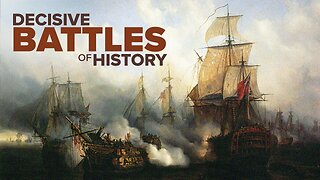Premium Only Content

The Italian Renaissance | The Recovery of Antiquity (Lecture 6)
Lecture 6: For Italians, the world of ancient Rome was their national history, one whose monuments, both physical and cultural, were everywhere to be seen. This rich tradition was increasingly regarded as an intellectual heritage to be mined for contemporary use, especially by lay rhetoricians and notaries who practiced the art of letter writing known as the ars dictaminis.
The clear and elegant Latin of the ancients could be recovered to replace the corrupted medieval Latin then in use; the ideals of classical thought in politics and philosophy could inform the city-states of the peninsula; and the principles of art and architecture could create a more humane environment in which citizens might prosper. As a result, there was a desire to know the past and recover as much of the ancient world as possible. Libraries were searched for lost ancient authors, and the discoveries were copied and edited for modern readers. The glory of the ancient past was, then, a model to be emulated and a golden age to be recovered so that its wisdom could be applied to the circumstances of Italy in the second half of the 14th century.
Primary Source Texts:
Kenneth R. Bartlett, “Humanism,” pp. 84–95, and “Art and Architecture,” pp. 223–239, in The Civilization of the Italian Renaissance.
Secondary Sources:
Roberto Weiss, The Renaissance Discovery of Classical Antiquity.
Supplementary Reading:
Leonard Barkan, Unearthing the Past: Archaeology and Aesthetics in the Making of Renaissance Culture.
Phyllis Gordan, Two Renaissance Book Hunters: The Letters of Poggius Bracciolini to Nicolaus de Niccolis.
-
 30:05
30:05
The Great Courses
1 month agoDecisive Battles of World History | 1942 Stalingrad - Hitler's Ambitions Crushed (Lecture 35)
165 -
 12:12
12:12
GritsGG
13 hours ago23 Warzone Wins in a Row! (Cypher AR)
77.7K2 -
 2:12:07
2:12:07
Side Scrollers Podcast
20 hours agoCULTURE SHIFT CAUSES MELTDOWNS + MASSIVE CENSORSHIP EFFORTS RAMP UP | SIDE SCROLLERS LIVE
19.9K9 -
 11:25
11:25
Nikko Ortiz
1 day agoMost Painful Fails
53.2K30 -
 43:55
43:55
pewculture
6 days ago $4.73 earnedIf the Purge was real, this is what we'd do... - EP#24
16.8K6 -
 8:14
8:14
MattMorseTV
1 day ago $11.12 earnedTrump just DROPPED the HAMMER.
61.7K72 -
 LIVE
LIVE
Lofi Girl
2 years agoSynthwave Radio 🌌 - beats to chill/game to
386 watching -
 22:39
22:39
BlabberingCollector
11 hours agoThe Alphabet Mafia Is Mad At JK Rowling AGAIN
23.3K5 -
 5:30:52
5:30:52
SpartakusLIVE
12 hours agoDuos w/ @GloryJean || #1 Masculine Muscle MASS sears YOUR retinas with MIND BENDING content
232K3 -
 3:05:49
3:05:49
TimcastIRL
11 hours agoNew DOCS PROVE Obama Hillary CONSPIRACY To SABOTAGE Trump Admin | Timcast IRL
240K146